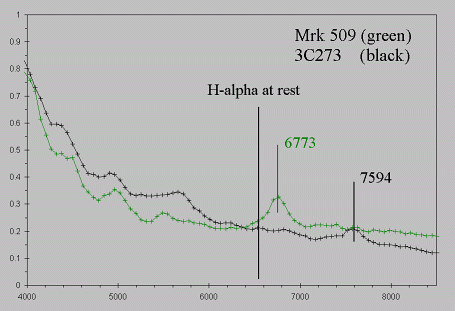
Spectroscopy of quasars

Comparison of the spectra of Markarian 509 and 3C273, obtained at a dispersion of 58.1 ┼/pixel. The vertical axis is arbitrary intensity, and the horizontal axis is wavelength in ┼ngstroms. The Ha lines have been marked for each spectrum,as well as the position of the Ha line at rest (6563┼). The measured redshifts agree well with the published results of 3.4% and 16%, respectively. It is suspected that some light, high cloud may have been present during the data run for 3C273, and only some 48 minutes of exposure were used for that object (compared with 75 minutes for Mrk 509). The relative shift in the position of the Ha line is clear.
![]()
PKS 1302-102, a quasar with a published redshift of 0.286, and an apparent V-band magnitude of around 15.5. This is a negative reproduction of a cropped and enlarged ST-6 image. The quasar is between the tic marks to the right of the image; its spectrum extends to the left, with the visible parts of the spectrum between the horizontal black lines. The short, vertical blue lines indicate the positions of two field stars which lie near or on the quasar's spectrum.
The above image was compiled from some 147 minutes' total exposure time, and was flat-fielded using a master flat derived from median-filtering all the night's exposures. There is a certain amount of noise in the sky backgorund, and another two or more hours' exposure would have been quite handy.
![]()
This image is a false-colour display of the same data, with different colours representing different intensities.
![]()
Another false-colour display, but scaled so as to bring out faint detail. Again, the quasar image is between the tic marks at the right. The short, orange bar to the left and top of the image shows the location in the quasar spectrum of what may be the Ha line. It is at the expected position given the z of 0.286, but it is to be noted that the data are quite noisy. The feature may well be due in part to noise, but the identification with the Ha line is tempting.
For z = 0.286, this line is shifted from 6563┼ to 8440┼. At this wavelength, the CCD has only about 2/5 of its maximum efficiency, so it is to be expected that the Ha line (if present...) and the continuum would be recorded only faintly. Assuming a Hubble constant of 70 km/s/Mpc, this quasar is at a distance of 1226 Mpc, or 4 billion light-years.